Shaved ice
Shaved ice is a large family of ice-based dessert made of fine shavings of ice or finely crushed ice and sweet condiments or syrups. Usually, the syrup is added after the ice has been frozen and shaved—typically at the point of sale. However, flavoring can also be added before freezing. The dessert is consumed worldwide in various forms and manners. Shaved ice can also be mixed with large quantities of liquid to produce shaved ice drinks.
| Type | Frozen dessert |
|---|---|
| Course | dessert, snack |
| Main ingredients | Ice, syrup |
Many shaved ices are confused with "Italian ice", called "granita". Italian ice, also known as "water ice", has the flavoring (fruit juice or other ingredients, like almond) incorporated into the sugared water before it is frozen. Shaved ice—especially highly commercial shaved ice (such as that found in food chains or from street vendors)—is often flavored after the ice has been frozen and shaved. Snow cones are an example of shaved ice that is flavored after production.
History

The first documented "shaved ice" dessert was made in 27 B.C.E. The Roman Emperor Nero sent slaves to collect snow from nearby mountains that he then flavored with a fruit and honey mixture.[1]
In imperial Japan, the dessert was also a treat reserved for royalty, as it was made of natural ice formed during the coldest period of winter, which was stored in icehouses. This made it very rare, and a supreme luxury available only to the Heian nobles; ordinary people could not afford it.[2] Halo-halo is believed to be an Filipino indigenized version of the Japanese kakigori class of desserts, originating from pre-war Japanese migrants into the Philippine islands. The earliest versions were composed only of cooked red beans or mung beans in crushed ice with sugar and milk, a dessert known locally as "mongo-ya". Over the years, more native ingredients were added, resulting in the development of the modern halo-halo.[3][4] Some authors specifically attribute it to the 1920s or 1930s Japanese migrants in the Quinta Market of Quiapo, Manila, due to its proximity to the now defunct Insular Ice Plant, which was the source of the city's ice supply.[5] As Japanese immigrated to Hawaii, they brought this tradition with them. Like Rome and Japan, in Hawaii warm areas are close enough to snow-capped mountains that snow can be brought into the warm areas without melting.
Regions
North America and the Caribbean
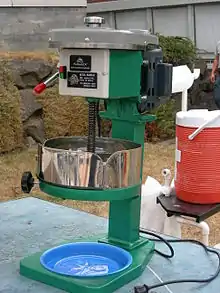

- In Canada and most of the contiguous United States, they are commonly known as "Snow cones" or "Snowballs", which consists of crushed or shaved ice topped with sweet fruit flavored syrup. Within the United States, several regional variations are prominent: New Orleans snowballs include a topping of fruit flavored syrup or a fruit-cream syrup mixture, and Baltimore snowballs frequently include a fruit flavored syrup and are then topped additionally with marshmallow cream.
- In Cuba, as well as in many Cuban neighborhoods in the United States, they are known as "granizados," after the Spanish word granizo for hailstones. In Miami, granizados are often sold in conjunction with other frozen confections in ice cream trucks and stands throughout the city. A classic Cuban flavoring for granizados is anise, made from extracts of the star anise spice.
- In the Dominican Republic and many Dominican neighborhoods, snow cones are called "frío frío", with "frío" being the Spanish word for "cold", or alternately called "Yun Yun".
- In Hawaii, they are known as "Hawaiian shave ice" or just 'Shave ice', and often resemble East Asian versions of shaved ice, with condensed milk and adzuki beans often added as toppings, while a scoop of vanilla ice cream is common at the bottom of the cone.
- In Mexico, as well as in some Spanish-speaking communities of the Southwestern United States, Texas, and California, a finely shaved and syruped ice is called a "raspa", or "raspado".[6] Raspar is Spanish for "scrape"; hence raspado means "scraped", referring to the ice. Raspados come in a wide range of fruit flavors and classic Mexican flavors, including leche (sweetened milk with cinnamon), picosito (lemon and chili powder), chamoy (fruits and chili sauce, known as chamoyada), cucumber, guanabana, guava, pistachio, and tamarind.
- In most of Puerto Rico and many Puerto Rican neighborhoods, they are named "Piragua", because they are made in pyramid shapes and agua means water in Spanish. In western Puerto Rico towns such as Mayagüez, they are called "raspao". Most Puerto Rican snow cone vendors use street snow cone carts instead of fixed stands or kiosks. During the summer months in Puerto Rican neighborhoods, especially in New York City and Philadelphia, "piragua" carts are often found on the streets and attract many customers.
- A Sno-ball is the New Orleans variant.
Central and South America
Central and South America shaved ice desserts have influences from both North American and Japanese cultures
- In Bolivia they are known as "Shikashika", where the ice is collected from the nearby mountains
- "Mermelada con hielo" (ice jam) is a local curiosity widely consumed in Rancagua, central Chile.
- In Colombia, Panama, Nicaragua and Venezuela they are called "Raspados" or "Raspaos" and are also topped with condensed milk and fruit flavors.
- In Costa Rica they are called "granizados" or "copos"; and when they have ice cream on the top, they are called "churchills".
- In Ecuador there are three versions. The ones sold at street carts and having ice which has been shaved manually with a handheld tool resembling a wood hand plane are called "raspados".[7][8] The ones sold at street carts, having ice that has been frappéd with a manually actioned rotary machine (some sellers use the handheld shaver, instead) and, are topped with condensed milk are called "granizados".[9] The "granizados" sold at stores are usually not topped and their ice is finely frappéd by an electrical machine and, for that reason, they will have more liquid even when just prepared.[10] "Raspados" and "granizados" sold at streets are much cheaper than "granizados" sold at stores.
- In El Salvador and other countries of the Region, they are known as "Minutas"
- In Guatemala they are called "Granizada" and are topped with condensed milk and fruit.
- In Guyana they are known as "Crush Ice" or "Snow Cone" and are topped with condensed milk.
- In Peru they are known as "cremolada" and in some parts of the country as "raspadilla".
- In Brazil they are known as "raspadinha" and in some parts of the country as "Gelo ralado com groselha" (redcurrant).
East and Southeast Asia
In East Asia, shaved ice desserts are not only flavoured with various types of syrup. It is also common to add solid ingredients such as red bean paste, jellies, canned fruits, jams, sweetened condensed milk, and many other types of sweetened foods to vary the textures of the ice dessert.
- In Taiwanese cuisine it is known as "Bàobīng" (刨冰; Mandarin Pinyin) or Chhoah-peng (剉冰; Taiwanese POJ). There are many varieties in Taiwan. Some of them are topped with canned fruits, fruits syrup and condensed milk. Other variations can be found throughout CHION.
- In Japan, the ice is known as "Kakigōri" (かき氷; かきごおり) and topped with fruit flavoured or plain syrup. Some shops provide colorful varieties by using two or more different syrups. To sweeten Kakigōri, condensed milk is often poured on top of it. During the hot summer months, kakigōri is sold virtually everywhere in Japan. Some coffee shops serve it with ice cream, dango and red bean paste. Convenience stores may also sell it already flavored and packaged similar to ice cream.
- In Korea, the shaved ices are known as "Patbingsu" (팥빙수). It is topped with sweetened red beans, (or pat, 팥),[11] fresh fruits, and soybean powder. Many other varieties can be found throughout the country. One variety that has been very popular in Korea since 2014 is snow flower bingsu ("눈꽃빙수"). It is made of extremely finely-shaved ice where the texture resembles real snow flakes. Also, rather than using plain ice, milk is added to the ice so that the shaved ice has milky flavor.
- In Cambodia shaved ice known as Teuk Kork Chus (ទឹកកកឈូស), is usually served during the hot summer days and during Cambodian New Years. Tuk (ទឹក) translate to water, Kak (កក) translates to ice; and Chhous (ឈូស) translates to shaved. This dessert is served with a variety of fillings such as jelly, basil seeds, jackfruit, taro, red beans, and more. After the filling the shaved iced is then filled to the top, then customers can choose a choice of different colored syrups usually in green, red, or blue; and condensed milk will lastly layer the top of the shaved ice.
- In Malaysia and Singapore, it is known as "ais kacang", which consists of shaved ice topped with sweetened syrup of various colours and flavours, condensed and evaporated milk, and sometimes also durian pulp or vanilla ice cream. Beneath the ice sweetened red beans, canned fruit, attap seeds and grass jelly are usually added. Electric ice shavers are often used; though some vendors may use a hand blade to shave the ice in order to produce a rough texture. A variation of this would be Cendol which is shaved ice with sweet green-coloured glutinous rice noodles drizzled with palm sugar; it is usually accompanied with kidney beans and canned sweetcorn.
- In Indonesia, it is known as "es campur", which is similar to the Malaysian/Singaporean ais kacang.
- In the Philippines, it is known as Halo halo which consists of shaved ice topped with sweetened beans and fruits, creme caramel (flan), nata de coco and ice cream. Halo-halo is believed to be an indigenized version of the Japanese kakigori class of desserts, originating from pre-war Japanese migrants into the islands. The earliest versions were composed only of cooked red beans or mung beans in crushed ice with sugar and milk, a dessert known locally as "mongo-ya". Over the years, more native ingredients were added, resulting in the development of the modern halo-halo.[3][4] Some authors specifically attribute it to the 1920s or 1930s Japanese migrants in the Quinta Market of Quiapo, Manila, due to its proximity to the now defunct Insular Ice Plant, which was the source of the city's ice supply.[5] "Halo-halò" literally means "mix-mix" in Tagalog. It is also found in mais con yelo.
- In Thailand, this kind of cold dessert is popularly known as "namkhaeng sai" (น้ำแข็งไส). Namkhaeng sai is served with a variety of toppings including red beans, toddy palm seeds, sticky rice, jellies, and preserved fruits, most often coconut. Then red syrup and condensed milk is liberally poured on top of the shaved ice. In other Thai desserts, the mixings are at the bottom and shaved ice is scooped on top. There are between 20–30 varieties of mixings that can be eaten. Among them are young coconut that has been soaked in coconut milk, black sticky rice, chestnuts, sweetened taro, red beans, sarim (thin strands of rice flour that is chewy and slippery) and many more.
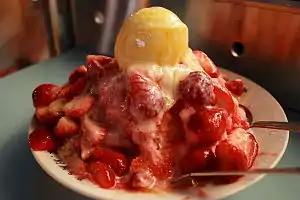 Taiwanese Baobing with strawberries and sweetened condensed milk
Taiwanese Baobing with strawberries and sweetened condensed milk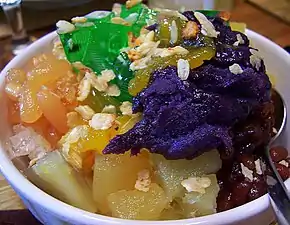 Filipino Halo--halò with brightly coloured toppings
Filipino Halo--halò with brightly coloured toppings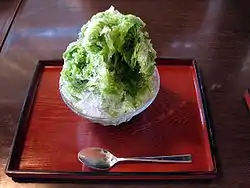 Japanese Kakigōri with green tea (matcha) flavoring
Japanese Kakigōri with green tea (matcha) flavoring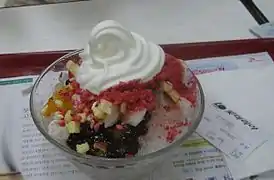 Korean Patbingsu with soft-serve ice cream and candied ingredients
Korean Patbingsu with soft-serve ice cream and candied ingredients
South Asia
In South Asia, snow cones are enjoyed as a low-cost summer treat, often shaved by hand.
- In Pakistan it is often referred to as Gola ganda (Urdu: گولا گنڈا), and it is flavored with multiple sugar syrups. fruits, condensed milk, ice cream, nuts, rosewater, and many other toppings. It is a very popular and well known street food.[12]
- In India known as Chuski; flavored with sugar syrups, fruit flavors and several other indigenous flavors like rose, khus, or kala-khatta. It is often topped with condensed milk. A literal translation of "Ball of ice" is used in many parts of India: Barfacha Gola in Marathi, Barf ka Gola in Hindi, and Barf no Golo in Gujarati. A similar version of shaved Ice can be found in northern Kerala known as Ice Orathi.
 A man preparing shaven ice in India
A man preparing shaven ice in India Shaven ice sold in the streets of India
Shaven ice sold in the streets of India Crushed Ice with flavored syrups in India
Crushed Ice with flavored syrups in India
Middle East
In Turkey, Bici Bici is the most known summer dessert. It is very light. Generally ices are brought from Toros Mountains to the city center. Starve, home-made syrup and optionally banana added.
In Israel shaved ice is known as 'Barad', which is Hebrew for hail (ברד), following the Spanish granizado. Sold year-long in kiosks on the streets and beaches, Barad, which is more of a slush drink than shaved ice, comes in multiple fruit flavors, the most common of which is grape.
Drinks
When large quantities of liquids are added to shaved ice, shaved ice drinks are produced
- Raspado – Mexican shaved ice drink
- Sâm bổ lượng, South Chinese and Vietnamese shaved ice drink/soup with jellies and fruits
- Cendol, South East Asian drink usually containing shaved ice
References
- Bell, Robert “The History of the Sno Cone.” Article Alley. 22 April 2009.
- Hamamatsu, Japan Visitor's Guide|http://www.inhamamatsu.com/recommend/japans-kakigori.php%7Cdate=May 2015
- Ocampo, Ambeth R. "Japanese origins of the Philippine 'halo-halo'". Philippine Daily Inquirer. Retrieved 23 April 2019.
- "Halo-Halo Graham Float Recipe". Pinoy Recipe at Iba Pa. Retrieved 24 July 2019.
- Crisol, Christine (2006). "A Halo-Halo Menu". In Zialcita, Fernando N. (ed.). Quiapo: Heart of Manila. Manila: Quiapo Printing. p. 321. ISBN 978-971-93673-0-7.
Today, many non-Quiapense informants in their forties and older associate the Quinta Market with this dessert. Why did this market become important in the invention of this dessert? Aside from its being a Japanese legacy in the area [...] of all the city markets, the Quinta was closest to the ice.
- Amy Chozick One Hundred Years of Craving Snow Cones From Texas to Tokyo, a reporter finds solace in the sweet and cold July 18, 2009, Wall Street Journal
- http://www.dailymotion.com/video/x27jp9v_el-granizado-guayaco-una-refrescante-tradicion-que-recorre-la-urbe_news
- http://www.eltelegrafo.com.ec/noticias/guayaquil/10/los-guayaquilenos-aun-disfrutan-de-los-tradicionales-raspados-2
- http://www.ppdigital.com.ec/noticias/ciudadania/4/los-raspahielos-calman-la-sed-en-las-calles
- http://www.eluniverso.com/2012/07/02/1/1445/populares-prensados.html
- 팥빙수 (in Korean). Doosan Encyclopedia. Archived from the original on 2009-04-05.
- "Beat the heat with Dhoraji's famous gola ganda". The Express Tribune. 2017-04-20. Retrieved 2020-12-22.
External links
| Wikimedia Commons has media related to Shaved ice. |
